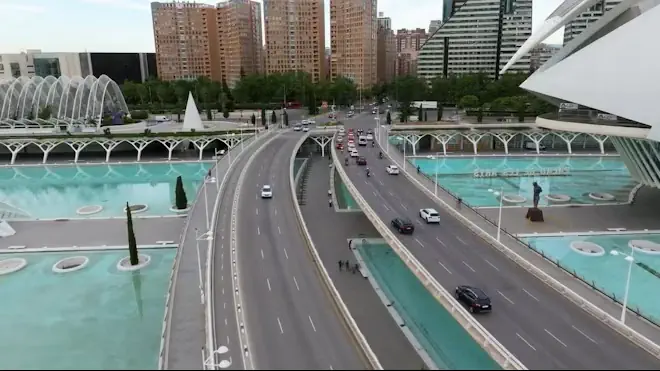VALENCIA, SPAIN – As a major Mediterranean hub, Valencia boasts a modern, integrated transportation system that facilitates movement for residents and visitors alike. The network includes, among others, an international airport, an extensive metro and tram system, a comprehensive bus fleet, manageable road traffic, and a public bike-sharing program. This infrastructure supports the city’s growing tourism and urban connectivity, with particular benefits for districts like Poblados Maritimos, the seaside neighborhood in the eastern part of the city.
Valencia Airport: Gateway to the City
Valencia Airport (VLC), located at just 8 kilometers west of the city center, serves as the primary entry point for international and domestic flights. It handles millions of passengers annually, connecting Valencia to major European cities and beyond. A key feature is its direct link to the urban area via Metrovalencia lines 3 and 5, which provide a convenient and affordable transfer. The journey to central stations like Xàtiva or Colón takes approximately 25 minutes, with trains departing every 10-20 minutes. Alternatively, the Metrobus line 150 offers a bus service, while taxis and ride-sharing options are readily available outside the terminals.
Metro and Tram System: Affordable Connectivity
Metrovalencia operates nine lines, combining underground metro and surface trams, covering over 150 kilometers across the metropolitan area. This network is identifiable by line numbers and colors, serving key zones including the historic center, beaches, and suburbs. Fares prices are very reasonable, with zone-based, single tickets, multi-journey options. Visitors will appreciate the Valencia Tourist Card, with unlimited travel and free museum entrance.
Extensive Bus Network
The bus system, managed by EMT Valencia, comprises over 50 lines that blanket the city and its outskirts. Daytime services run from 4:00 a.m. to 10:30 p.m., with night buses extending coverage until early morning. Stops often feature real-time digital displays showing wait times, averaging 12 minutes during peak hours. The fleet includes over 500 accessible vehicles, integrated with the metro for seamless transfers. Interurban Metrobus lines extend to surrounding towns, enhancing regional connectivity. The fleet is rapidly modernizing with the recent massive purchase of 84 Electric and Hybrid buses.
Fluid Traffic and Road Infrastructure
Valencia’s road network benefits from ring roads and well-maintained highways, contributing to relatively fluid traffic compared to larger Spanish cities. Travel times from suburbs to the center typically range from 20 to 40 minutes, even during rush hours. The city’s layout, with wide avenues and efficient signaling, minimizes congestion. For drivers, parking apps and zones are available, though public transport is often preferred for its efficiency.

Fluid Traffic and Road Infrastructure
Thanks to Valencia excellent road infrastructure and public transportation, travel times from suburbs to the center typically range from 20 to 30 minutes, even during rush hours.
ValenbiSi: Eco-Friendly Bike Sharing
ValenbiSi, Valencia’s public bike-rental system, promotes sustainable mobility with over 2,700 bicycles across 275 docking stations around the city. Users can rent via an app or card, and the rates are very affordable. The network aligns with the city’s bike lanes, covering coastal paths and urban routes, making it a practical —and often the best— option for short trips.
Connections to Nazaret District
Our Sleek Lofts are located in Nazaret, part of the Poblats Marítims (Seaside Neighborhood) district on the coastline. It’s a perfect example of how good is the system integration: from Valencia Airport, travelers can reach Nazaret via Metro line 5 to Xàtiva, then transfer to line 10 surface Metro. Bus lines like EMT routes 30 and 32 provide direct links to the city center and beaches. Traffic in the area remains manageable due to proximity to major roads like the V-30 highway. ValenbiSi stations are scattered throughout Nazaret, facilitating easy access to nearby attractions such as Cabanyal Beach or the Marina. This connectivity supports the district’s role as a gateway to Valencia’s eastern coastal areas, blending residential life with tourism.
Overall, Valencia’s transportation system stands out for its affordability, coverage, and multi-modal options, ensuring affordable, easy and fast navigation across the city and its districts.

